So many choices! How do I choose the pashmina that's perfect for me?
Pashmina shawls are customarily quite large and light, which is why they are so versatile. Even Asian women, who are typically rather small, wear fullsize shawls quite comfortably; because of the light weight of the fabric, the shawls are easily knotted, folded, and wrapped, so that the generous dimensions are never a liability.
On the contrary, the remarkable variety in the ways a shawl can be worn is a great part of its appeal.
When it comes to size, the terminology is rather troublesome. In Kathmandu, stole is a term that refers to what we call a medium-size shawl (80 inches by 28 inches). The scarf is a somewhat smaller piece (usually 80 inches by 24 inches). What we Americans generally mean by scarf is much narrower, and in Nepal would be called a muffler .
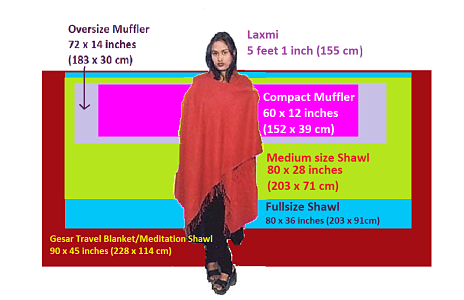
To summarize our current product line...
We have two sizes of shawl:
Mufflers come in two sizes, both suitable for men or women.
We have two blankets:
In the image above, Laxmi (a Nepali woman of average height) is shown with rectangular figures representing our various size wraps drawn to scale. The silhouettes are lined up on the top, which makes it a bit to interpret. Note that the full-size is the same length as the medium-size, but about 22% narrower.
There are three factors to consider: composition , weave , and density .
Composition: Briefly, we offer pure pashmina (which is cashmere, harvested from goats); silk/pashmina blend; and modal, a semi-synthetic made from plant fiber. Most of our embroidered shawls are made of fine sheep's wool, usually merino.
Now we're really going to have to get into the weeds, because many companies are exploiting the confusing terminology to trick people into paying more than they need to, and getting a product that will probably not satisfy them.
Pashmina is cashmere, but the word is also used to refer to anything that looks like a typical pashmina shawl, regardless of composition. Oy! For more information, read our About Pashmina page
To be clear: our Pumori, Sagarmatha, and Tamserku shawls are all made from 100% pashmina (= 100% cashmere); our Ama Dablam shawls are made from a blend of 70% pashmina (cashmere) and 30% silk.
There are two basic ways of making fabric: knitting and weaving. We do have some knit goods -- cardigans, baby blankets, ponchos -- but all of our shawls (except the semi-synthetic modals) are hand-woven on a loom that has not changed much since weaving was invented. (We do not use automatic looms of the sort used by large-scale purveyors.)
To understand the differences among our weaves, you have to understand a few terms. The loom is set up with long warp threads strung at a relatively high tension, which is necessary in order to keep the weave straight. Pashmina (cashmere), the undercoat or down of particular breeds of goats, is not the strongest natural fiber; goats grow this stuff to keep them warm, and they grow a much stronger kind of hair to protect the undercoat and the skin from scratchy bushes, bugs, rain, dirt, and so on. Pashmina shawls are woven only from the fine undercoat, which has remarkable insulation properties and is extremely soft. As a result, the fabric is not as tight or robust as silk, cotton, or synthetic materials.
The weaver sits at one end of the loom apparatus, with the warp threads extended horizontally away from his or her station. The weaver lays down weft threads perpendicular to the warp. The weft thread is laid across the warp threads, which are displaced up and down to accept the weft in the proper arrangement. The in-and-out arrangement of the weft with relation to the warp threads is what characterizes the weave.
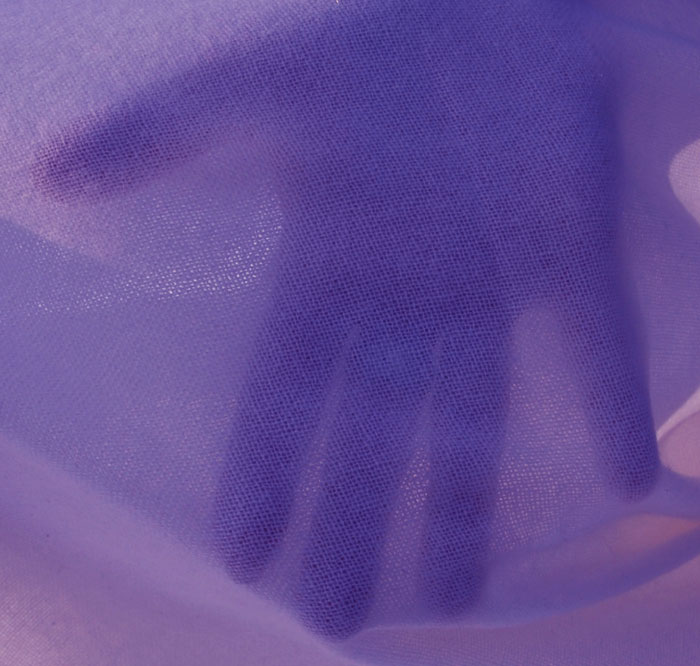
Sagarmatha, our 100% pashmina basic-weave fabric.
Sagarmatha is our own term for a basic square one-up-one-down weave. Fabric woven in this style out of 100% pashmina seems rather loose, almost gauzy, extremely soft, with a puffy buttery feel. We generally use 28/1 pashmina yarn both for the weft (sideways thread) and warp (lengthwise thread). The designation 28/1 means that one kilogram of the yarn would stretch 28 kilometers, and that the thread is a single ply. Shawls can also be made with heavier or lighter weight yarn, and they can be double ply (or even triple); multiple ply threads are made by twisting threads together before weaving. Obviously, heavier thread can be used to make heavier and warmer shawls, but what we are looking for is not a garment that can be substituted for a parka or a horse blanket. Pashmina shawls are have generous dimensions, so that they can be folded and draped with a high degree of versatility and elegance. Light weight is a premium value.
Tamserku shawls are twill weave, which means the weft is laid down across the warp at a jog rather than a straight criss-cross checkerboard, with a resulting diagonal ridging that is quite evident if you examine the fabric up close, but not so evident when viewed from conversational distance. Our Tamserku shawls are double-weight, and therefore heavier and warmer than our Sagarmatha shawls.
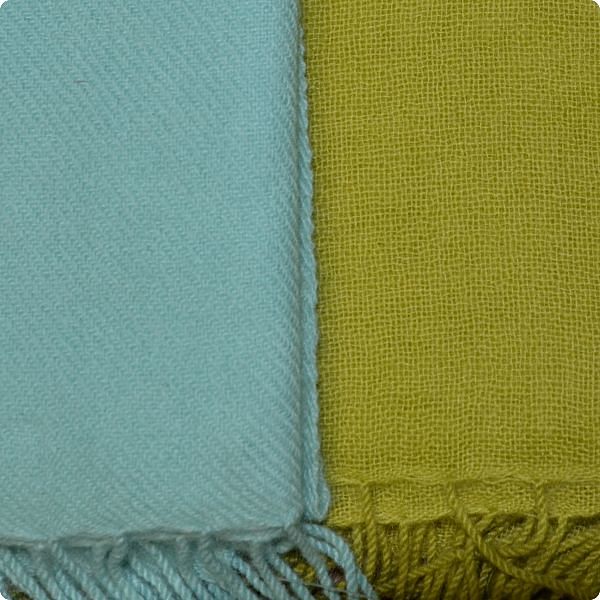
Twill and basic weave (right) 100% pashmina shawl, compared
Pumori is our own term for a fabric that Kathmandu weavers usually call "superfine diamond-weave." The 120-count thread is much finer than our other weaves, definitely not for someone who appreciates a hefty shawl. It is woven in a traditional diamond pattern known as chashm-e-bulbul , or eye of the bulbul. Actually, there are many species of bulbul, and they belong to the Pycnonotidae family of medium-sized passerine songbirds. (See bulbul photo, below.) Due to the tight weave, this fabric is labor-intensive and it costs a bit more.
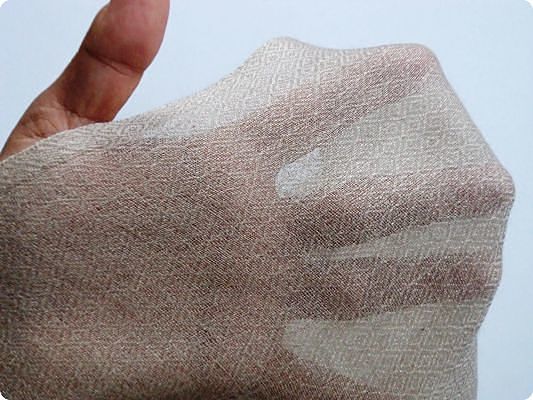
Superfine Pumori weave.
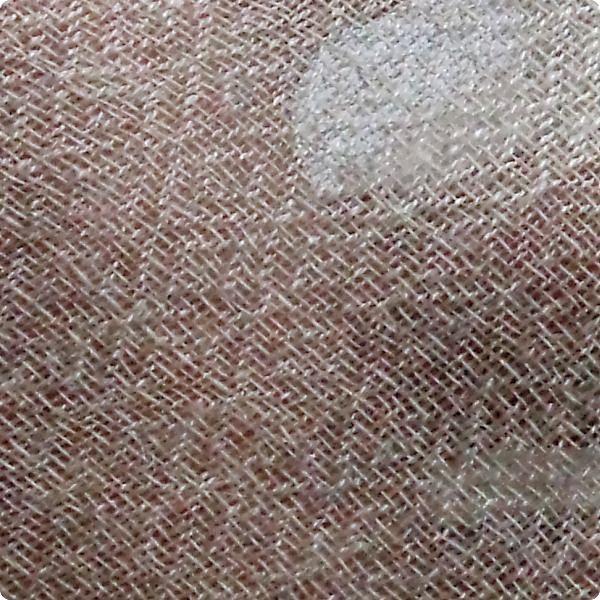
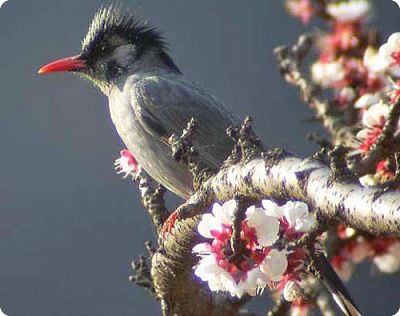
The Black Bulbul, one of the bulbul species from which the traditional name of our so-called Pumori weave may derive. (Photo courtesy of Wikipedia)
70% pashmina/30% silk is the international trend-setter, combining the warmth of cashmere wool and the durability of silk. Many people believe that the fiber itself is a blend of cashmere and silk. In fact, the weft (sideways) threads are the same 28/1 cashmere as in the 100% pashmina shawl, while the warp (length-wise threads) are 210-grade silk -- which is comparable to a very fine human hair. Due to the silk, which is much more dense than the pashmina, the blended shawls have a more elegant drape, and can support beading and embroidery. They also have a bit of a sheen, and are not as likely to snag. On the other hand, they are nowhere near as soft, and for their weight they are not as warm as the pure pashmina shawl.
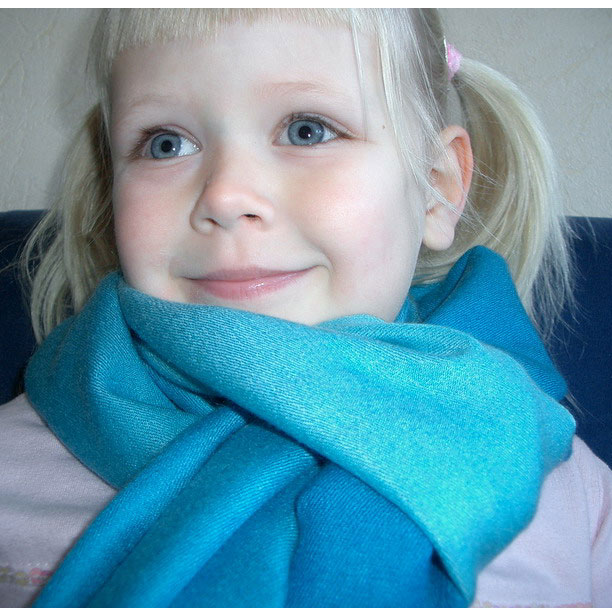
70/30 muffler.
The issue of density is often linked to the ply count of the yarn. Ply , the same root that occurs in multiply, plywood, pliers, and imply, simply means fold ; in the context of cloth it refers to the elemental spun thread, which may or may not be twisted together with one or more similar threads to form a thicker thread. Single-ply is a fabric made with elemental threads; double-ply or two-ply fabrics are made with yarn that is formed by twisting two threads together. Knitting yarns are often composed of upwards of four plies.
Thicker threads are easier to weave due to the reduced likelihood of breaking as well as the decreased set-up time and the lower number of shuttle swipes needed to complete the shawl.
Another supposed advantage of double-ply yarn is that the twist can be set against the twist of the elemental threads, and thereby reduce the torque that can distort a fabric shape, moving seams and zippers and degrading the fit, particularly in knit goods.
However, torque is not a serious problem in simple woven fabrics. Pashmina products are also soaked and massaged to relax the threads, making torque a non-issue. Quite the contrary, fine thread and high count (threads per linear unit) fabrics are preferred for their light weight and ethereal feel
To be clear, few of the current shawl producers in Kathmandu are using true double-ply yarn. Triple-ply and other multiple yarns are now used almost exclusively for knitted goods.
Shawl producers in Nepal generally use the adjustment of paddles in the loom to control fabric density rather varying the number of plies in the yarn. Four-paddle weaves are twice as dense as two-paddle. For the most part, we sell four-paddled 70/30 shawls and mufflers, and two-paddled 100% pashmina shawls.
One further remark: in pashmina shawls, more is not better. If it were, you would be wearing bed-spreads rather than shawls. The modern pashmina shawl has evolved to meet women's desire for a warm AND light wrap. The paddle-adjusted shawl may be a shade less dense than a double-ply, but it has undoubtedly achieved its international success due to the fact that it so successfully achieves the desired balance of warmth and weight.
Weft yarn may be twisted into tassels, both to prevent unraveling and for ornamentation. Ragged or eyelash fringes are the standard alternative, and they are stabilized with weft-wise stitching or serging. There is no universal standard for fringe length; three-inch (8 cm) knotted fringes on wraps (full-size, medium, and muffler) is fairly typical, but some fringing is shorter, and eyelash fringe is increasingly popular.

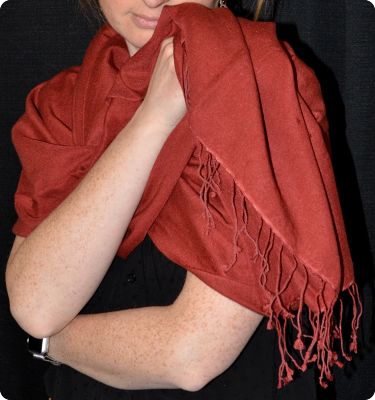
Medium size 70% pashmina/30% silk, with ragged (natural) fringe, in Strawberry and Medium size 70% pashmina/30% silk , with tassels, in Marsala
Email Seth at seth@sunrise-pashmina.com
Or call us at (607) 256-0102. Night or day.
If we can't answer immediately, we'll get back to you. Soon.
Sunrise Pashmina
511 W. Green St.
Ithaca,
NY 14850 USA
